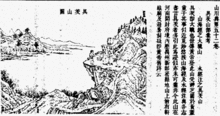Jiang Tingxi
Jiang Tingxi (simplified Chinese: 蒋廷锡; traditional Chinese: 蔣廷錫; pinyin: Jiǎng Tíngxí; Wade–Giles: Chiang T'ing-hsi, 1669–1732[1]), courtesy name Yangsun (杨孙), was a Chinese painter, and an editor of the encyclopedia Gujin Tushu Jicheng (Complete Collection of Ancient and Modern Writings and Charts).


Jiang was born in Changshu, Jiangsu. Besides the name Yangsun, he was also known by his courtesy name Youjun (酉君), as well as the pseudonyms Nansha (南沙), Qingtong Jushi, Qiujun, and XiGu (西谷).
The 5020-volume state-sponsored encyclopedia Gǔjīn Túshū Jíchéng (古今图书集成; 古今圖書集成; 'Complete Collection of Illustrations and Writings from the Earliest to Current Times') was published in 1726 and had been compiled by Chen Menglei and Jiang Tingxi during the reigns of the Kangxi and Yongzheng emperors in the Qing dynasty.
As an official painter and grand secretary to the imperial court, Jiang used a wide variety of artistic styles, and focused particularly on paintings of birds and flowers. He was also proficient in calligraphy. His works influenced later court painters, including Yu Sheng(余省), Yu Zhi(余稚).
Although better known for his Gujin Tushu Jicheng, Jiang also contributed—along with other scholars—in the compilation of the "Daqing Yitongzhi" ('Gazetteer of the Qing Empire').[2] This geographical gazetteer was provided with a preface in 1744 (more than a decade after Jiang's death), revised in 1764, and reprinted in 1849.[2]
Apart of cultural activity, as a holder of the jinshi degree Tinxi performed the important duties in the Qing government's Office of Military Finance, on par with Zhang Tingyu (headed by Yinxiang, the Yongzheng Emperor's brother).[3]
Notes
- Barnhart: Page 379.
- Fairbank & Teng, 211.
- Spence, The Search for Modern China, p.80-81
References
- Barnhart, R. M. et al. Three thousand years of Chinese painting. New Haven, Yale University Press. 1997. ISBN 0-300-07013-6
- Fairbank, J.K. and S.Y. Teng. "On the Ch'ing Tributary System," Harvard Journal of Asiatic Studies (Volume 6, Number 2, 1941): 135–246.
- Nie, Chongzheng, "Jiang Tingxi". Encyclopedia of China, 1st ed.
| Wikimedia Commons has media related to Jiang Tingxi. |